Fast Food Marketing: Top Strategies, Channels, and How to Measure Success
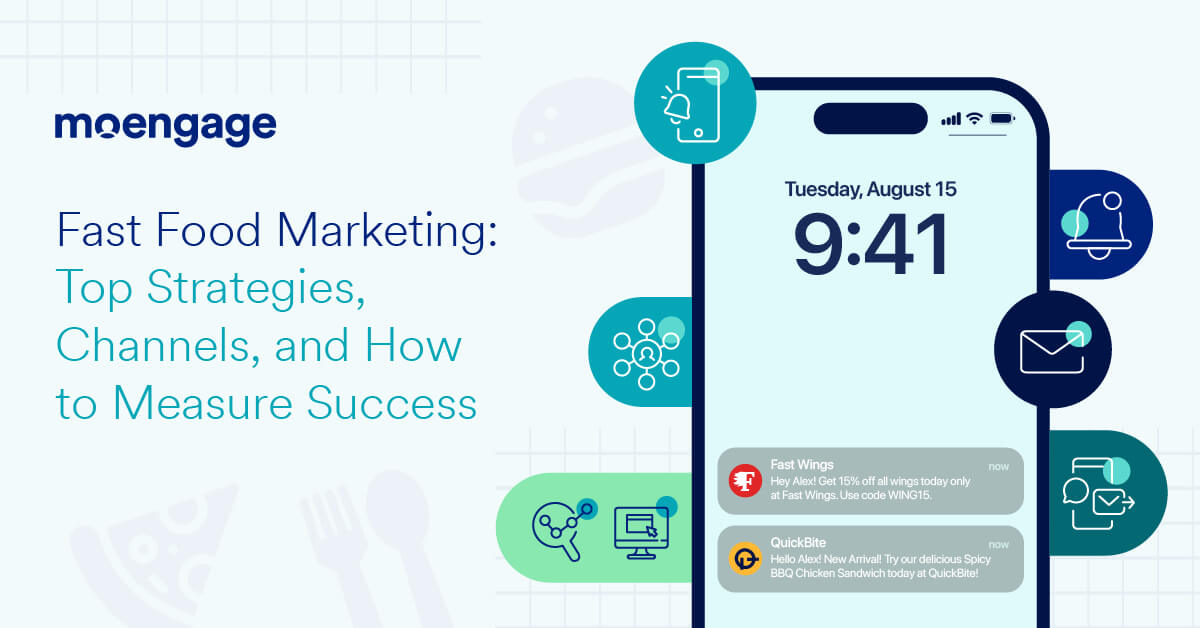
Reading Time: 18 minutes
For fast food brands, long-term success isn’t just about a one-time sale, it requires repeat orders.
The challenge for QSR marketers is that taste is uniquely subjective and extremely personal in nature. Personal preferences play a major role, as do social, cultural, and even emotional factors.
Fast food brands looking to capture customer attention have a more difficult time, as that attention is spread out across a multitude of channels which are both online and offline.
Marketing initiatives that previously saw major success no longer work in today’s digital climate. For example, when first conceived, McDonald’s PlayPlace was extremely successful at drawing in its target audience — families with young children. However, in today’s world of online ordering, curbside pickup, and mobile delivery, fewer customers are eating in stores, making PlayPlaces far less appealing as a fast food marketing tool.
The fast food space is no longer just brick-and-mortar restaurants looking to get customers to eat in-store, but hybrid establishments that exist — and sell — offline and online.
As fast food, quick service restaurants (QSRs), fast casual establishments, and even online delivery services surge in popularity, brands need to adjust their marketing strategies to meet these changing needs.
To help brands excel at fast food marketing, we explore what it is, why it’s so important for success, and the top strategies for QSR marketers to use.
What is Fast Food Marketing and What Does It Entail?
Fast food marketing is used by fast food brands and other quick service restaurants (QSRs) to promote their products and services. It involves leveraging customer activity and behavior data to understand consumer preferences and craft targeted, personalized marketing campaigns that drive engagement.
Top brands use fast food marketing to increase both online and offline sales, product awareness, and brand loyalty.
Importance of Fast Food Marketing for Brand Retention
Success in the fast food industry isn’t just about driving one-time orders, it’s about attracting brand loyalists who will enroll in your rewards programs and make repeat purchases. This makes fast food marketing critical for capturing this attention.
According to our survey of Food & Beverage marketers, increasing customer engagement or loyalty is the top priority for the industry, with 46.8% of respondents listing it as most important to them.
When done properly, fast food marketing helps you:
- Increase visibility: Get your restaurant in front of new and existing customers, increasing exposure so you can acquire customers and drive engagement.
- Establish your brand: Build brand recognition by delivering consistent communication across all channels and campaigns that reflect your brand’s identity.
- Foster meaningful relationships: Develop deep, long-lasting relationships with customers based on effective marketing communication that resonates with your audience.
- Increase product stickiness: Develop seamless, intuitive customer experiences that customers love, ensuring customers prefer your products and service over competitors.
- Incentivize active engagement: Provide contextually relevant campaigns that motivate customers to participate in contests and rewards programs, as well as place orders.
- Inform data-driven decisions: Leverage deep omnichannel analytics from your fast food marketing campaigns to understand and predict customer behavior, and make data-driven optimizations.
Ultimately, fast food marketing is a customer acquisition and retention strategy that is focused on driving engagement.
12 Fast Food Marketing Strategies to Increase Sales
Brands use fast food marketing to drive sales by improving customer engagement. This increases the number of orders, order value, and customer lifetime value (CLV), allowing companies to grow their revenue (and their brand).
But that’s easier said than done. Top QSR marketing leaders use the following strategies to drive traction and increase sales:
1. Onboard customers with welcome messages and sequences
New customers that aren’t familiar with your brand won’t intuitively know how to navigate your app or website and place an order.
Studies show that the highest drop in retention rate occurs within the first few days of app installation.
Successful fast food marketers use onboarding sequences to welcome new customers, familiarize them with their service, and teach them how to place orders. By educating customers on how to use their product and service, brands are able to reduce customer friction, increasing adoption, engagement, and stickiness.
The McDonald’s app enters customers into a guided onboarding sequence that shows them how they can use the app, so they can easily make a purchase when ready.
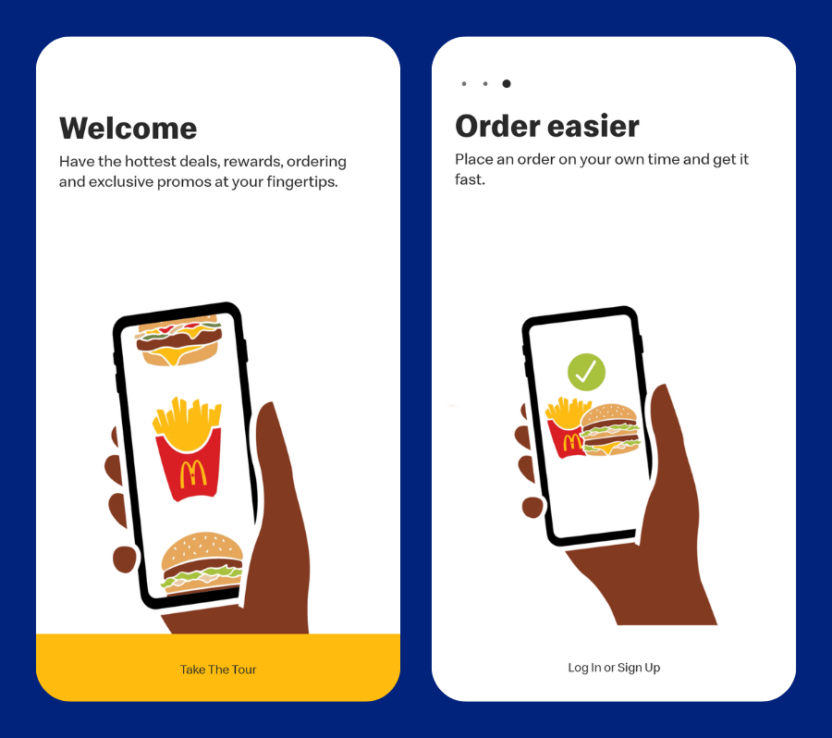
Many brands trigger welcome sequences in-app, if that’s where the customer signs up with the service. If the signup doesn’t occur in-app, many brands initiate the onboarding messaging over channels like email, so customers can complete the process on their own time.
The onboarding phase is a great opportunity to foster early engagement by offering new customers exclusive welcome offers.
For example, SkipTheDishes offers new customers 5,000 bonus points on a purchase made in their first 5 days as part of their welcome campaign.

2. Send relevant product recommendations, offers, and communication
Taste is very subjective, and is therefore dictated by personal preferences. People like vastly different types of foods and restaurants, and even have particular meal preferences. That doesn’t even factor in dietary restrictions and requirements that further limit what customers want to eat — and order.
To get it just right, fast food marketers need to ensure that they are sending customers relevant food and beverage offerings and recommendations for better conversions.
Domino’s ensures their product recommendations are relevant by personalizing them based on previous customer activity such as searches and orders.
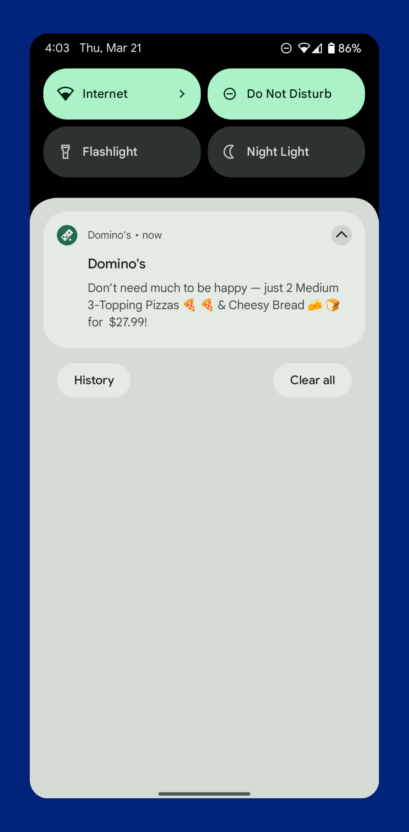
Here, Domino’s is providing an offer of items the customer typically orders through the mobile app, increasing the likelihood of a purchase. The message is also timed perfectly to give the customer enough time to consider this option before dinner. This interaction goes beyond just this immediate sale though; customers that get relevant offers and messages are far more likely to consistently engage and convert.
Domino’s didn’t stop here though. Their omnichannel strategy put them in a position to track drop-offs, enabling them to better predict abandonment and step in and take action to mitigate churn.
3. Leverage generative AI to drive engagement
Fast food marketers are constantly trying to engage a variety of different customer types and segments at once, from young savvy tech users that are eager to buy online to older customers that may not be as adept at online ordering.
For these brands to engage customers at scale, they’ll need to be able to use generative AI that can automatically create optimized copies and messages that resonate with customers, in real-time.
Whether it’s for emails, mobile push notifications, SMS messages, or customer chat services — using generative AI helps teams develop engaging and intelligent copies at scale.
Wendy’s is experimenting with a generative AI platform that will take drive-thru orders via a chatbot style solution. Aimed at enhancing customer experience, Wendy’s FreshAI saves labor costs and increases order accuracy. FreshAI uses generative AI to take drive-thru orders, generate responses, and adapt in real-time. The result is a top-notch, personalized, and responsive experience for every customer.
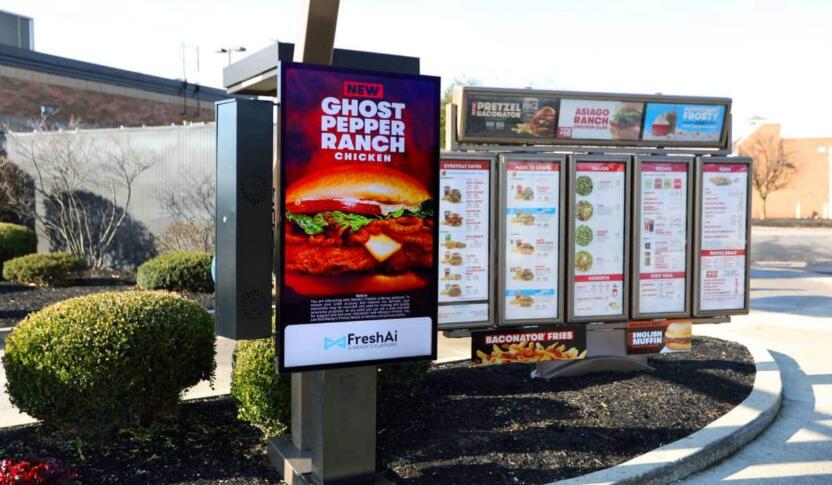
Wendy’s is also exploring plans to integrate AI with its app, in-restaurant kiosks, mobile devices, smart home devices and more, to provide a seamless, personalized, and omnichannel customer experience.
Marketers are just beginning to tap the potential of generative AI in fast food marketing. As we move forward, it will be pivotal in enabling brands to execute personalized, omnichannel marketing campaigns at scale.
4. Use an omnichannel approach to customer engagement
Modern customers are looking for speedy, convenient experiences online and in-store. Fast food brands need to take an omnichannel marketing approach, ensuring customers can connect with them via any touchpoint, seamlessly.
Omnichannel fast food marketers can leverage a variety of channels as part of a single, cohesive customer engagement strategy, to reach their customers wherever they are.
Domino’s executes its engagement strategy using an omnichannel approach, optimizing channel selection based on the type of message to improve open rates, click-through rates, and conversions.
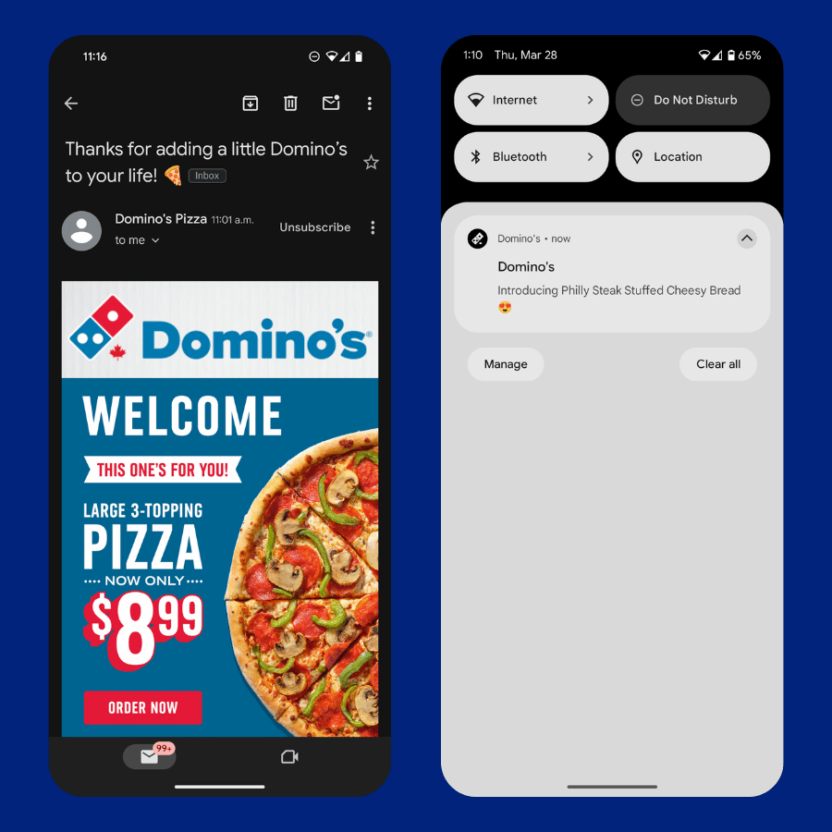
They use email for sending welcome messages that onboard new customers and incentivize engagement with a welcome bonus. After customers have been onboarded, mobile push notifications and in-app nudges encourage regular engagement by notifying customers of new products, active sales, offers, and contests.
5. Incentivize brand loyalty and regular engagement with a rewards program
Becoming your customers’ go-to restaurant isn’t just about offering the best food, it’s also about offering incredible customer experiences that keep customers connected, interested, and actively engaged with your brand. It means convincing them to choose you over your competitors, and then remain loyal for the long haul.
Rewards programs are a great way to motivate customers to become brand loyalists who think of your brand first and choose your brand over competitors. More than that, they provide fast food marketers with opportunities to incentivize engagement with your brand.
Most leading fast food brands run a rewards program: McDonald’s has MyMcDonald’s Rewards, Starbucks has Starbucks Rewards, and Domino’s has Domino’s Rewards. But for these programs to be successful, they have to provide incredible experiences that keep customers connected and actively engaged.
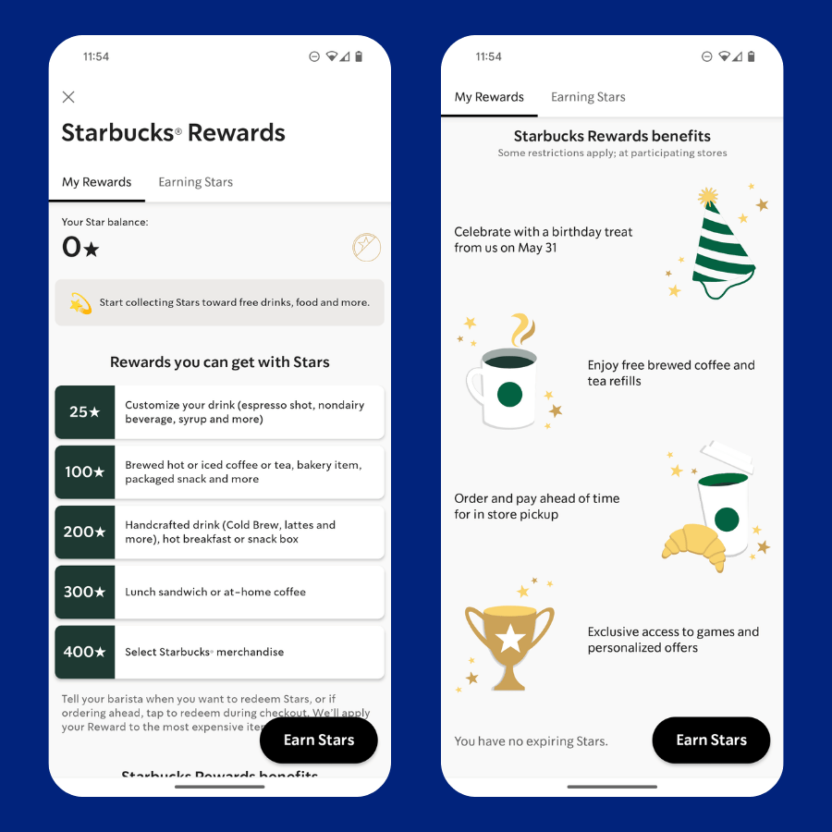
Starbucks finds success by making their Rewards program very simple to participate in and understand. Customers only need to download the app and sign up to be a member to collect points. The app makes it extremely easy to track and spend points, as well as engage with available offers for bonus points.
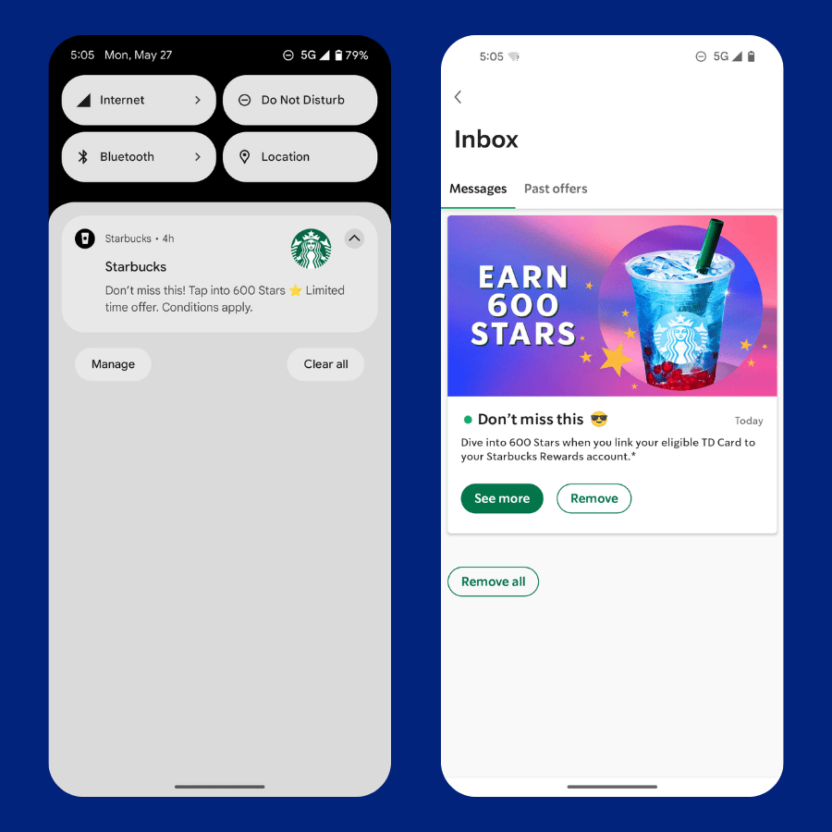
Starbucks easily communicates with customers that have signed up for their Rewards program, as they can connect with them via channels like email and mobile push. But Starbucks takes this even further, encouraging regular engagement by giving customers bonus rewards points for making purchases.
Furthermore, the Rewards program allows Starbucks to gather more customer insights, allowing the brand to make its communication more personalized.
Ultimately, Starbucks succeeds on mobile because their app makes it easier for customers to order their favorite drink, snack, or merchandise before they get to the store. Customers can pay (and tip) online and get their items quickly and conveniently whether it’s being delivered or they are picking it up in-store. Basically they can do virtually everything (except drink their Starbucks) from the app, including fill their card and track their rewards. The app also makes it easy for customers to cash in their points and get free rewards.
Fast food brands can use a similar strategy to convert customers into loyalists to ensure repeat sales, sell new products, collect feedback, and increase sales even during quiet seasons.
6. Drive FOMO – and engagement – with limited-time products and promotions
Fast food brands can’t expect customers to return to make regular purchases, they have to give them a reason to come back every month. Limited-time products and sales increase engagement by providing customers with products, deals, and experiences that they don’t want to miss.
Encourage participation with your marketing campaigns by driving FOMO and building hype around limited-time sales. Build marketing campaigns around these sales that squeeze out the most engagement from customers.
Starbucks often maximizes engagement with their limited-time BOGO sales using a carefully timed mobile push sequence that notifies customers of the sale a day before and on the day of the sale. This ensures customers know about (and can plan to partake in) the sale a day before it starts. Further reminding them on the day of the sale ensures customers don’t miss out, leading to greater conversions with the limited-time offer.
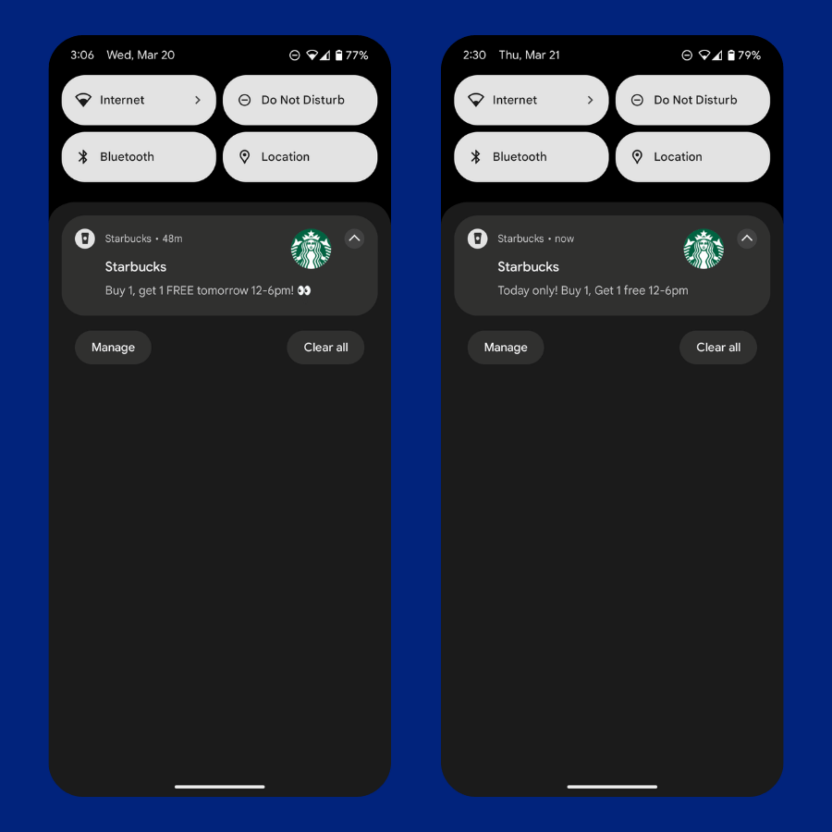
Similarly, Burger King regularly promotes limited-time menu items and deals around major holidays to keep existing customers interested and draw in new visitors.
Last holiday season, they used this strategy to maximize app engagement by making a number of their limited-time deals digital exclusives that required customers to download and interact with Burger King’s app.
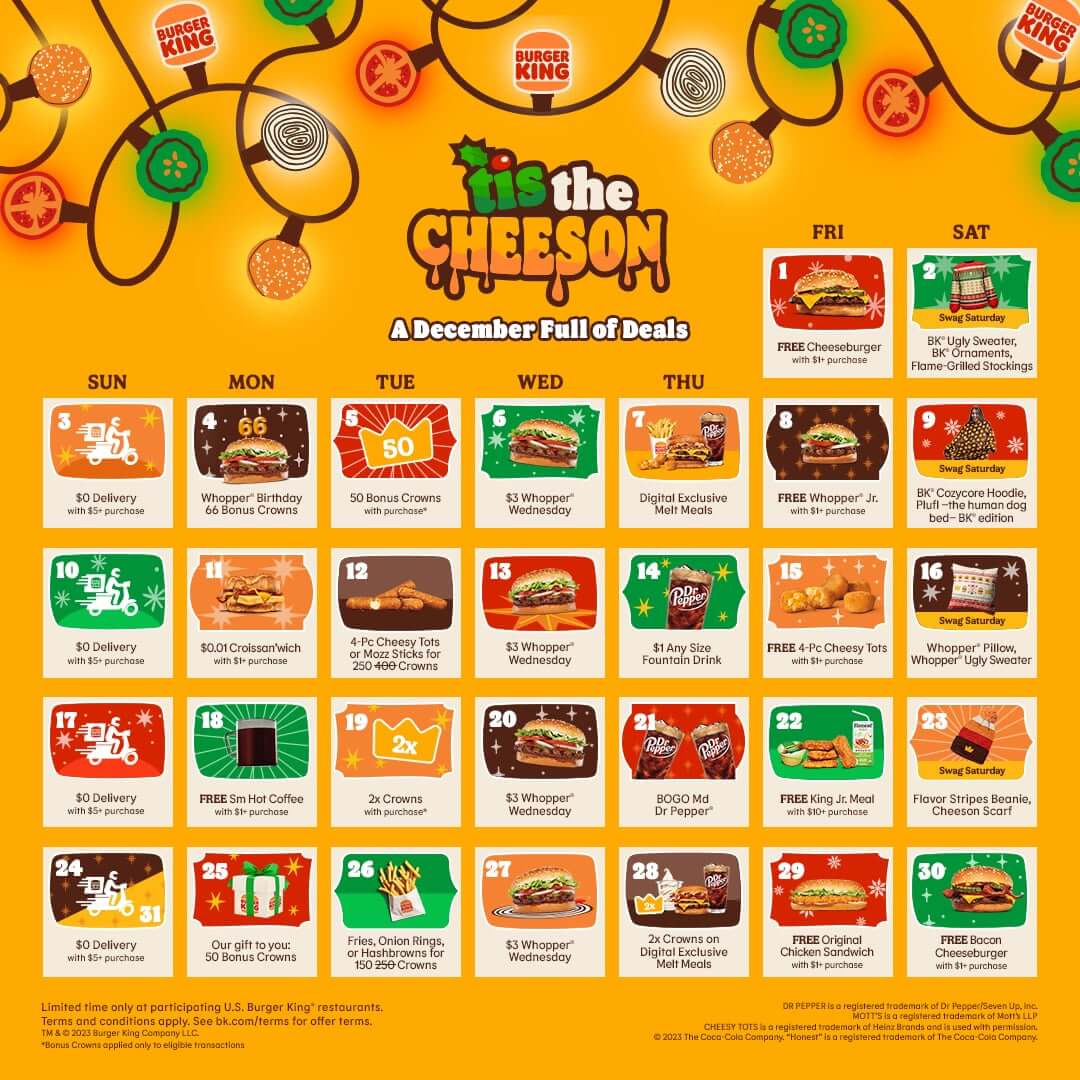
7. Orchestrate customer journeys that make ordering a breeze
Fast food customers are looking for convenient experiences that are quick and easy, and that includes the ordering experience. Leading brands orchestrate seamless customer journeys that save customers time ordering and checking out.
Domino’s uses a mobile push to activate the customer and get them to engage with an offer. The entire sequence is based on — and built around — the customer’s initial interaction. The mobile push allows them to jump straight to the order stage with a single click, saving them time browsing and selecting items mentioned in the deal.
By having a pre-loaded checkout process based on the mobile push the customer clicked, Domino’s reduces friction and saves customers time on their checkout. This keeps customers on track while ordering, limiting cart abandonment and driving conversions.
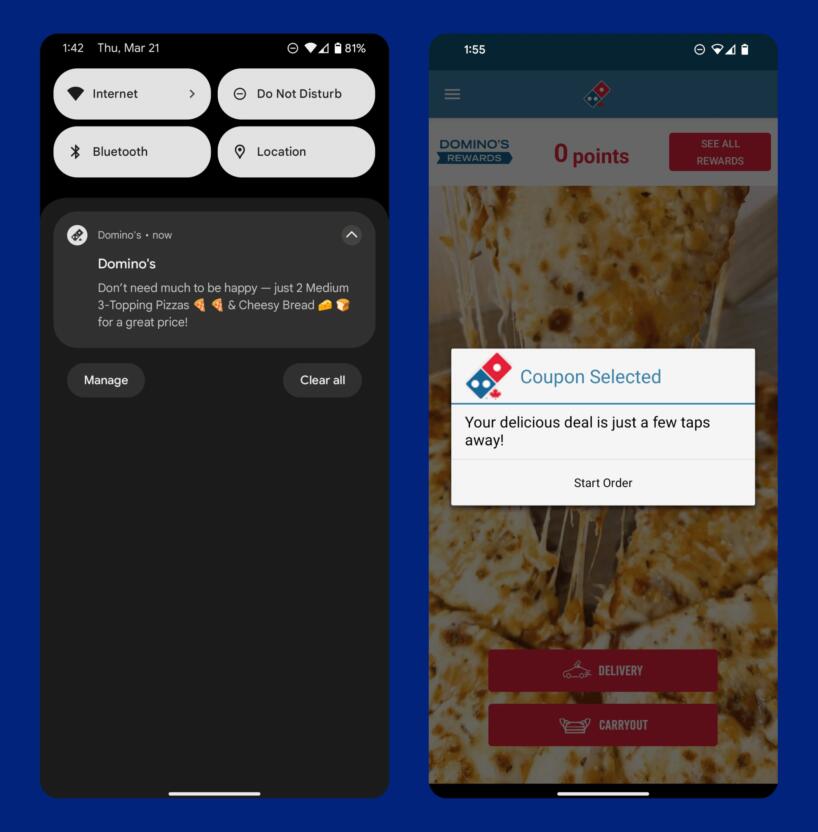
8. Use in-app messaging to drive sales
In-app messages allow fast food marketers to direct customer attention where they want it. When used effectively, they help brands nudge customers towards a specified action, whether that’s a Rewards program registration, leaving a review, or completing their pending order.
Customers who are already shopping in-app have a high purchase intent. Brands capitalize on this intent by using in-app messaging that automatically triggers in response to customer activity, ensuring communication is always timely and relevant.
Uber Eats uses in-app messaging to connect customers with a limited-time promotion, drawing them in and encouraging them to try their service.
These are timed to be delivered when the customer’s intent to buy is high. This makes it easy and convenient for the customer to take advantage of this offer, and helps Uber Eats improve their sales.
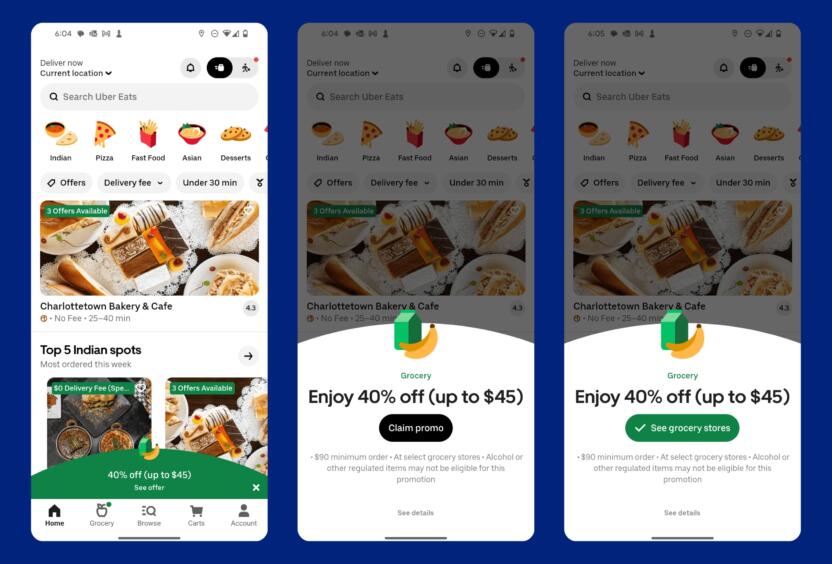
9. Promote new products or offerings via mobile push for greater engagement
Fast food marketers need to promote their brand’s products, but they also need to actively drive customer engagement. One of the best ways to engage customers is to use mobile push notifications.
Mobile push notifications alert customers of new products, upcoming and current promotions, service changes, and more. More importantly, they can push customers further down conversion funnels, helping you get customers to take particular actions, like placing an online order.
Even if push notifications don’t result in an immediate conversion, they spread awareness that can lead to a future purchase, whether that’s online or in-store.
With high view, open, and click-through rates, mobile push is the perfect channel for ensuring visibility on limited-time marketing campaigns and important communications.
Starbucks regularly uses mobile push notifications to promote new products, like this line of seasonal drinks for the summer. Whether or not someone clicks the mobile push and immediately places an order, it still alerts them of the new product. The customer may never open the push notification, but could visit a store a week later to try one of these new drinks.
Either way, the mobile push has done its job.
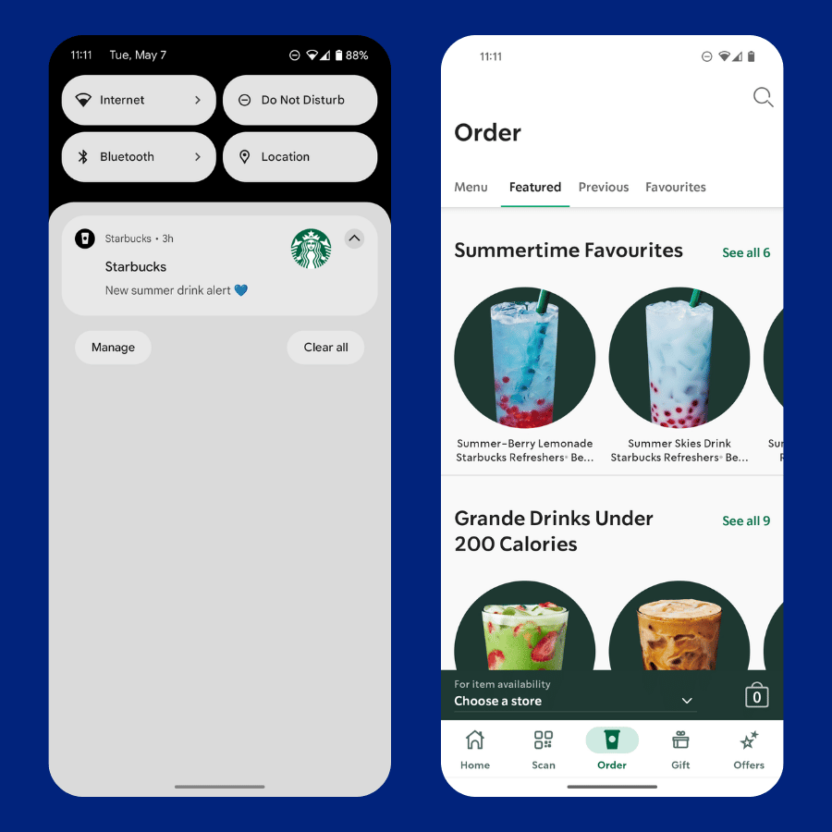
10. Reactivate dormant customers and turn them into active users
Fast food marketing isn’t just for keeping active customers on track to buy, it can also be used to bring back lost or dormant customers through targeted reactivation campaigns.
Using personalized, omnichannel campaigns that leverage channels like email, mobile push, and SMS, fast food brands can capture the attention of dormant customers and get them back to being active customers.
Leading brands — like SkipTheDishes and UberEats — send targeted mobile push notifications designed to reactivate customers who have gone dormant.
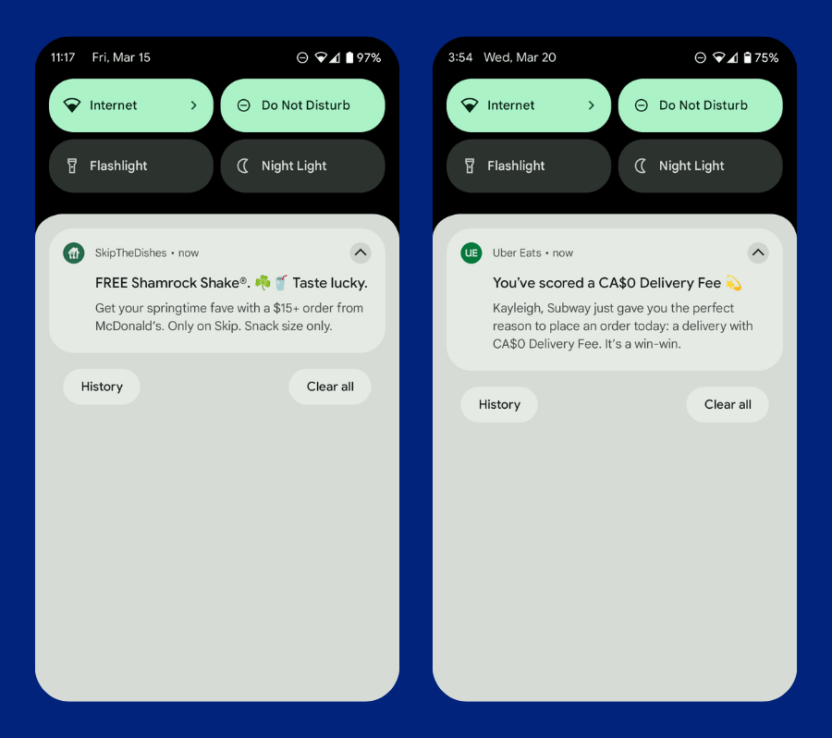
Consistent, relevant messaging that connects a dormant customer with the right offer can get them back to being a monthly active user (MAU).
11. Gamify experiences to increase engagement and stickiness
People love games because it allows them to compete and work towards objectives, tracking their progress along the way.
Gamifying customer experiences goes a long way in building engagement with customers that feel a sense of accomplishment and thrill when engaging with your campaigns.
McDonald’s Frequent Fryer Program gamifies its limited-time rewards event by getting customers to enter codes on the mobile app. This not only increases engagement with the program and incentivizes sales, but it also encourages actual app adoption, engagement, and stickiness by having customers input their codes and track their rewards in the mobile app.
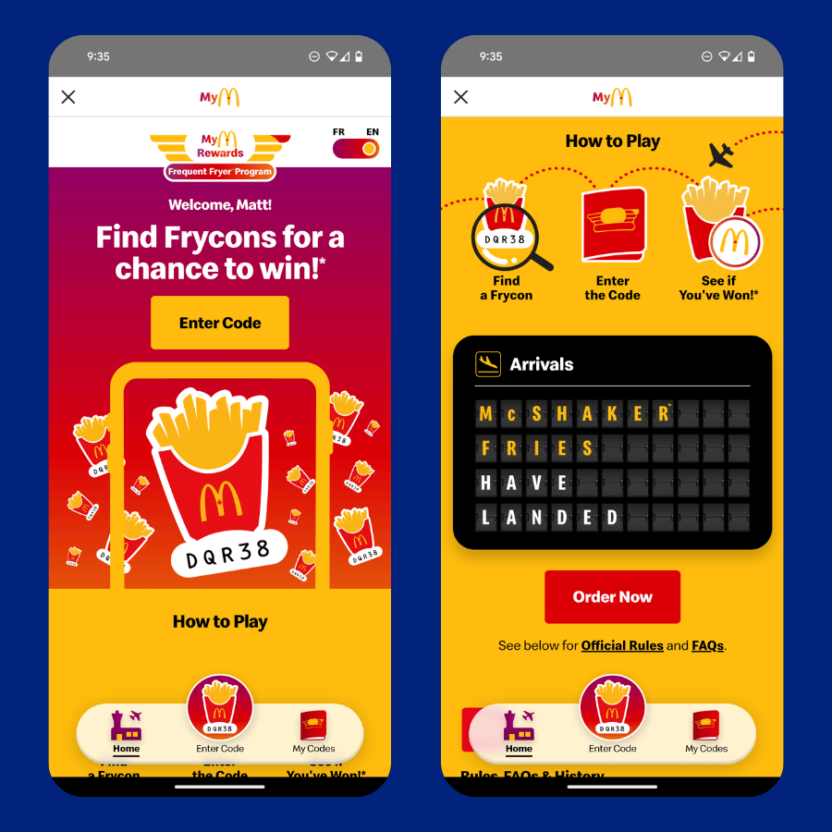
12. Leverage customer insights to upsell and cross-sell effectively
Fast food brands make their revenue almost exclusively through orders; the more valuable these orders are, the more revenue they generate and the more valuable each customer acquisition is.
Effective upselling and cross-selling enables brands to increase their average order value (AOV) and — ultimately — customer lifetime value (CLV).
McDonald’s uses contextual in-app messaging that automatically triggers after a customer adds an item to their order by clicking ‘Add to Bag’.
These recommendations are curated based on a number of factors, including the customer’s past purchases, searches, and segment behavior. This allows McDonald’s to serve relevant recommendations that improve upsell efficiency and drive more revenue.
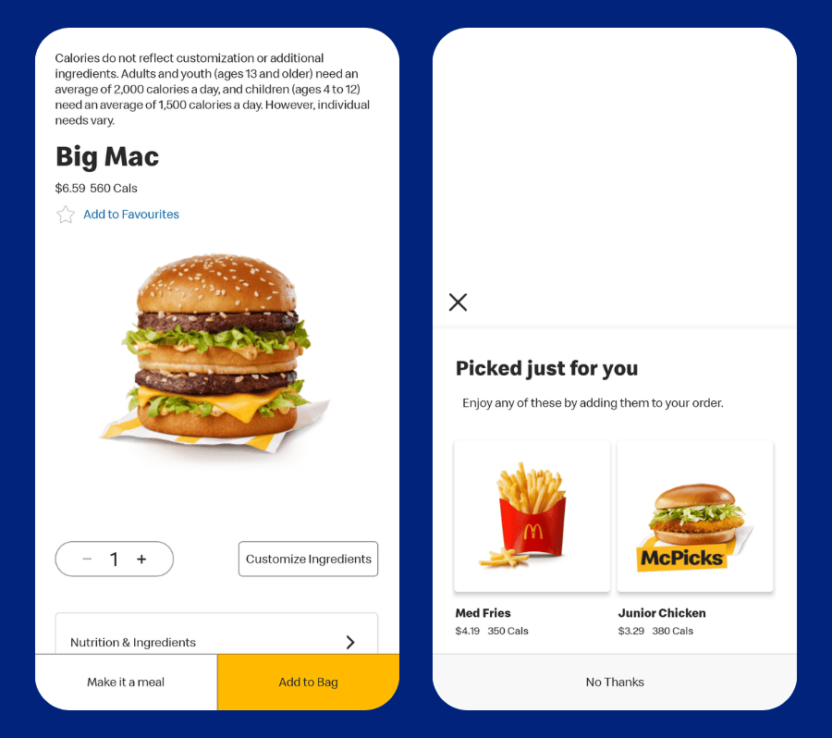
Fast Food Analytics: How to Measure the Success of Your Marketing Strategy
Concrete metrics are important to judge the efficacy of any fast food marketing campaign.
The following key performance indicators (KPIs) can help you measure the success of your fast food marketing efforts:
1. Engagement rate
For fast food brands to have success, they need to drive customer engagement that fosters deep brand loyalty and leads to repeat purchases. This means getting customers to actively engage with the brand and come back to place orders on a regular basis.
There are various ways to measure customer engagement, as there are a myriad of ways that customers can interact with your fast food brand.
But fast food marketers can calculate the engagement rate for apps/websites over a certain period of time by looking at the total active users as a percentage of total users.

Engagement rate analytics can be further segregated by:
- Day, week, or month: This helps to assess how effective the app/website is in engaging customers.
- Channels: This helps assess how impactful each marketing channel is in engaging customers and to derive which channel is the most effective.
- Features: This helps assess how effective each feature on the app/website is in engaging customers and to derive which feature is the most popular.
Knowing the engagement rate of different aspects allows marketers to take insights-led decisions and make relevant optimizations, to further improve engagement.
2. Conversion rate
Before fast food restaurants can focus on retention and loyalty, they need to generate revenue by getting visitors to place orders (and become customers). This makes conversions one of the most important metrics for fast food brands.
The conversion rate is the percentage of visitors that perform a specific action. In most cases, this action is a completed order. However, a conversion can track any completed action, including an account creation, a Rewards sign-up, or even just a click on a specific offer or message.

The conversion rate is a strong indicator of the success of your overall marketing efforts, and can be used to compare the performance of individual campaigns, channels, and more. It shows how effective your marketing campaigns are in leading to sales, helping you improve your outreach and funnel orchestration.
Conversion isn’t everything, though. Fast food brands will also need to implement strategies to ensure customers come back to make repeat purchases.
3. Repurchase rate
More than other industries (like those that can sell high-value items and have fewer recurring purchases), fast food restaurants rely on repeat purchases to thrive. They need customers to come back to order again to increase their customer lifetime value (CLV).
The repurchase rate is the percentage of customers who make more than one purchase.

It is an early indicator of retention and a major contributor to increasing CLV.
This metric enables fast food marketers to understand which customer segments are bringing the most value so they can more effectively target high-value customers that will drive CLV.
4. Monthly Active Users (MAU)
MAU is a common metric for measuring the true strength and value of your customer base. While brands can tout high download numbers, if those customers aren’t actively using a service, they aren’t likely to see a profit.
MAU is the number of customers that engage with a service or platform at least once a month. It’s a great indicator of how many active customers you have and the overall performance of your customer retention efforts, as it shows you how many customers are actively using your service on a regular basis.
MAU doesn’t need to be calculated, it needs to be tracked, as it’s simply the number of unique users that access a service in a single month.

This value can then be used to determine monthly averages and compared year-on-year, as well as evaluate the percent of visitors that are turning into MAU. Brands can even look at daily vs monthly active user ratios to see how well they’re driving consistent engagement and brand loyalty.
MAU is an invaluable metric for QSRs that operate a mobile app or website, as it’s a strong indicator of customer engagement. Consistent app/web users often develop into brand loyalists that will continue to use your service each month.
5. Online sales volume
With sales increasingly shifting to digital platforms, online sales volume is a more important signal of success than ever before. Many modern businesses rely on digital sales to stay afloat, with modern consumers opting for delivery and pickup options that prioritize convenience.
Fast food brands will need to analyze their online sales performance, comparing individual channel performance and stacking it up against offline sales. This will allow marketers to analyze how their brand is doing online, whether that’s on desktop or mobile devices. They can also do year-on-year comparisons to understand how much growth they have been achieving.
6. Delivery rate
If your messages never make it to their intended recipients, they’ll never be able to attract and convert customers.
Message deliverability is often measured using the delivery rate, which is the percentage of messages that are successfully delivered out of the number of messages that are sent.

It’s a common metric used to track performance of channels such as email and push notifications.
High delivery rates ensure your campaigns are seen, which is the first step in gaining a new customer, having a customer place an order, and return to your service regularly.
7. Open rate
Getting the message to your customers is only the start — without opening and clicking through, you’ll never generate leads or get them to place an order.
The open rate is the percentage of customers that open a marketing message out of the number of people that receive it.

Overall, it’s a good indicator of campaign engagement, as it tells you how many customers open and view the marketing materials you send. However, while it does tell you how effective you are at eliciting interactions, if you want to know how effective you are at driving orders — you can look at your conversion rate numbers.
Fast Casual Marketing Channels to Improve Customer Engagement
A critical component of perfecting your fast food marketing campaigns is channel selection. Identify your priority channels and analyze which channels are best for different types of messages and use cases. For example, email is well suited for welcome campaigns, but isn’t as great for time-sensitive offers in the way mobile push excels. Based on the use cases and analysis of customer preference, you can build an elaborate omnichannel strategy.
Below, we look at the top 5 channels fast food marketers use to drive engagement (according to our survey of Food & Beverage marketers), as well as provide tips on how marketers can use these channels effectively to increase engagement, conversions, and retention.
Email is still the most popular marketing channel for fast food marketers, and for good reason. It has a wide reach and it’s extremely simple to develop these campaigns compared to other channels, making email an appealing choice for a variety of message types.
Email can be used in dynamic customer journeys and to funnel customers effectively towards conversions using an omnichannel approach. They are great for welcome sequences, customer onboarding, and notifying customers of upcoming events and sales.
| 🎯 MoEngage helps you leverage email as part of your omnichannel fast food marketing strategy, empowering you to increase deliverability, open rates, and click-through rates to ensure you connect with your customers and effectively martial their attention. |
Social Media
Social media is the second most popular marketing channel, and it’s particularly popular with younger generations.
Customer segmentation and behavioral data empower fast food marketers to maximize the value of their advertising spend by more effectively targeting their marketing campaigns.
Social media is ideal for attracting customers to your fast food service in the first place, but it’s also great for reactivating lost and dormant customers by increasing brand exposure.
| 🎯 MoEngage helps you expand your reach with optimized social media ad campaigns based on in-depth insights and analytics. With the right fast food marketing strategy, you can reduce customer acquisition costs and re-engage customers on their preferred channels with personalized, contextually relevant social media campaigns. |
Desktop Website
For most digital businesses, a website is a staple channel for engagement; and this is no different for fast food marketers.
Desktop website experiences are ideal for lead generation and sales, as visitors can browse menu offerings, see featured promotions, download the app, and more. But it’s also essential for providing basic information about the brand itself. This is commonly where consumers can find information about the company, including company and product updates, customer support, and contact information.
| 🎯 MoEngage understands how important a desktop website is for a fast food brand’s digital presence. That’s why we enable you to send website push notifications to engage customers throughout their journey, driving opt-ins, higher click-through rates, and conversions. We help brands maximize engagement by delivering web push notifications at the perfect moment based on real-time activity. |
Mobile App
Modern consumers prioritize mobile apps for services they regularly and constantly engage with. This is especially true for fast food services, where customers want a quick, convenient experience with little friction.
Fast food brands use in-app messaging to curate experiences, sequences, and communication that engages and converts customers more effectively.
| 🎯 MoEngage helps brands deliver personalized, contextually relevant in-app messages that capture customer attention at the right moment. This allows you to push customers in the right direction to accelerate engagement and motivate customers to take a specific action. With our help, fast food brands can build complex in-app campaigns that convert — and upsell/cross-sell to — customers more effectively. |
Mobile Website
More than other industries, fast food customers prioritize mobile engagement. Consumers need to be able to look up menus, restaurant hours, and more on the go, making a mobile website a critical marketing tool.
Also, a mobile website is an ideal channel to engage with customers that may be hesitant to download your app, but still want to access your services on-the-go. However, your website will need to be optimized for mobile and include all the features that your mobile app and desktop site have.
This is also a great channel to use to nudge customers towards downloading your app, especially if they come back to use your mobile site repeatedly.
But fast food brands can do so much more with their mobile sites than simply share their menu and contact info. Instead, brands need to leverage in-app messaging to orchestrate seamless on-site experiences that funnels customer attention and drives engagement and conversions.
| 🎯 MoEngage helps fast food marketers perfect their on-site messaging so they can deliver recommendations, promotions, and offers in real-time based on customer intent and journey stage. Build customized experiences with ready-to-use templates and customizable content cards that get you started and design on-site messages for your customers in minutes that resonate with your customers and match your brand’s identity. |
Master Fast Food Marketing with MoEngage
Fast food and QSR brands have a difficult challenge ahead of them. More than other industries, they rely on repeat purchases, and need to acquire loyal customers that will come back to make repeated orders.
But food is also extremely personal; customers have very specific and unique preferences and dietary requirements, making it extremely difficult for marketers to speak to all their customers.
Fast food marketing helps brands acquire customers, drive omnichannel engagement, build brand recognition and loyalty, and increase overall sales.
In the increasingly digital fast food landscape, leading brands are excelling by providing digital-first experiences that leverage an omnichannel approach and deliver personalized experiences and messaging that customers love. MoEngage’s customer engagement platform uses an omnichannel approach to fast food marketing, empowering brands to connect with their customers across any and all channels. We build hyper-personalized omnichannel campaigns that resonate with customer desires and preferences to increase traction and engagement.
Schedule a demo today to learn how we can streamline and automate your fast food marketing efforts.


















